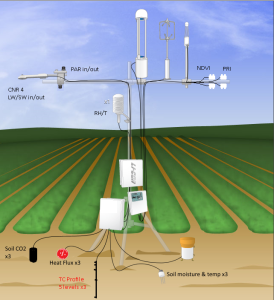(Dennis Baldocchi, author.) I have a new graduate student who is taking introductory classes with a diverse group of environmental science students. In their discussions, they are comparing how each one does their science. So in our weekly discussions, the question came back to me as to “What is our Method?”

This is a good question. It dawned on me that as flux scientists, we don’t seem to have a formal name for what we do. But we do have a method and procedure derived from the scientific method, despite the fact we are often guilty of collecting lots of data then diving into in and seeing what we see. But we are studying a complex system that operates at multiple scales and exhibits emergent scale properties. So many of us feel what we do is justified.
What is it we do? We aim to analyze and distill multifaceted datasets to understand the temporal and spatial variations of trace gas fluxes. Having been primered on early papers by the Monteith and Jarvis groups and lessons from my professors, Verma, Rosenberg and Norman, many of us take a rather classical approach towards analyzing our data and writing our papers. Typically, we:
- Evaluate the climatic, plant and soil conditions associated with our study to describe the baseline and base conditions
- It is quite popular to look at mean diurnal patterns of fluxes for given time windows to identify any particular stresses
- With long term datasets it is necessary to compute daily sums and plot and integrate the sums on annual time scales
- Next comes trying to examine sources of variability of these fluxes. This may involve using Fourier Transforms, Wavelets and more recently Granger Causality, Mutual Information and Transfer Entropy theories
- Assessing 2 and 3 dimensional response functions is also a tried and true method. Plotting fluxes against such variables as absorbed light, soil moisture, temperature, leaf area index yield good information on light, carbon and water use efficiencies.
- We then like to understand how our site may relate to the larger world. Distilling our measurements in a greater context by synthesis with AmeriFlux and Fluxnet Data is done by comparing data across climatic or ecological gradients, or comparing across plant functional groups or management/disturbance regimes is becoming more informative.
- Finally, it is important to interpret empirical response functions with those that can be deduced by models, as they can isolate variations among variables and avoid confounding effects. Choices may include a hierarchy of simple to complex biophysical models (e.g, SIB-II, CLM, CANVEG) or Bayesian model-data fusion models like SIPNET.
- Finally collaborating with colleagues to upscale our data in time and space with models and remote sensing helps us address the so what questions and address societal needs for our information.

No Comments
Be the first to start a conversation